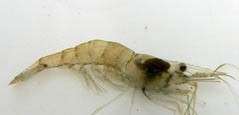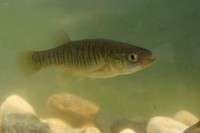For some crustaceans in polluted waters, it could be worse

(PhysOrg.com) -- Imagine that you’re a grass shrimp. Now, imagine that you’re a rational grass shrimp, and that you have a choice of living in an environment with relatively high levels of dioxin, poly-chlorinated biphenyls (PCBs), and other floating nastiness or a relatively unpolluted environment with clean water and plenty of food.
Which would you choose?
The clean environment, right? It’s not that simple, according to Judith Weis, a professor of biology at Rutgers-Newark.
“If your predator is worse affected (by the pollution) than you are, you can do well,” says Weis, who published her research recently in Bioscience. “Put another way, if your predator is leaving you alone for some reason, or is just a lousy predator, you can do okay.”

Weis explains that earlier studies suggested that grass shrimp ate less in polluted environments than in clean ones. But killifish, which eat grass shrimp, are much worse off in polluted environments: They swim slower, catch prey less efficiently, eat less and grow slower. As a result, grass shrimp can live longer and grow bigger. Because they’re poor at catching live food, the killifish eat more “junk food” – sediment and detritus – which is not nutritious for them.
Weis and her co-authors, former graduate students Lauren Bergey, Jessica Reichmuth, and Allison Candelmo, studied five species of marine life living in parts of the Hackensack Meadowlands and Piles Creek (which runs into the Arthur Kill between New Jersey and Staten Island) in northern New Jersey, and in clean Great Bay, near Tuckerton in southern New Jersey. Though the Hackensack Meadowlands and Piles Creek have gotten much cleaner in the last 40 years, they are still polluted with dioxin, PCBs and other toxic chemicals. The sediments there still contain metals: copper, lead, zinc, cadmium, chromium and mercury.
Fiddler crabs from Piles Creek tend to be less active on the bottom, eat less, and spend more time in their burrows, the researchers found. Lab experiments indicate that fiddlers from the polluted waters were better at avoiding blue crab predators, possibly because they spent more time in burrows.
Bluefish have it worse. They spawn at sea, but spend their first summer in estuaries, some of which are polluted. Weis and her co-authors analyzed the stomach contents of juvenile bluefish (“snappers”) caught in the Hackensack Meadowlands and in clean waters of Tuckerton. They found that most of those caught in the Meadowlands had empty stomachs, higher levels of contaminants, and were smaller than the well-fed snappers from cleaner environments. Researchers fed the clean-water snappers killifish from polluted waters, or from clean water. They found that fish fed contaminated prey swam slower, ate less, and grew slower than fish fed clean food. Worse, at least potentially, is that bluefish that live in polluted waters may eat more heavily contaminated killifish, because they’re easier to catch. Bluefish bioaccumulate contaminants – that is, the contaminants stay in their tissues when they eat contaminated prey, and therefore pose a risk to human beings who might catch and eat those fish.
Blue crabs may have the best deal. In relatively clean waters, according to Weis, they eat a more normal diet – with lots of smaller crabs, small fish, and mollusks. In the polluted Meadowlands, they eat a lot of sediment, detritus and algae – which is unusual. In lab studies, crabs from the polluted environment were found to be poor predators on active prey like smaller crabs and fish, which may explain the diet of algae and detritus. Despite their odd diet, blue crabs in the Meadowlands appear to grow all right and be abundant.
They may grow bigger because they live longer. They may live longer because human beings are forbidden to catch them in polluted northern waters, precisely because those waters are so polluted.
And there’s something else the blue crabs have in the north or that they obtain after being fed a northern diet in the lab: attitude. “They’re really nasty and aggressive,” Weis said. “When we caught some blue crabs down at Tuckerton, put them in a container and took them up to the lab, two hours away, they were all fine when we got them home. But when we captured some in the Meadowlands, and opened the container in the lab 20 minutes later, they’d started killing each other. We don’t know exactly why that is. But they do come from a tough neighborhood.”
Provided by Rutgers University


















